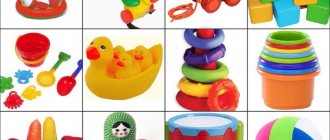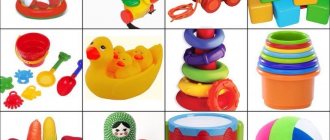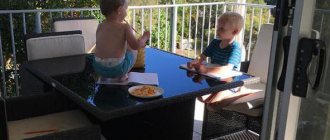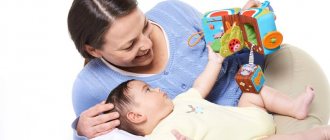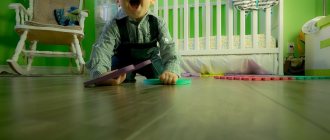Every parent has at least once wondered what my baby should be able to do and know in order to develop harmoniously, keep up with his peers and not experience difficulties in the future when entering school. Especially when an example is given to a child who at 4 years old reads books on his own and plays the violin.
The criteria for developmental requirements for preschoolers are different. On the one hand, child psychologists strongly advise not to take away childhood from children. Fill it with fun, walks, games, creativity. It is recommended to start regular training sessions at the age of five.
On the other hand, the modern world of information and technology is so dynamic that parents fear that in the two years before school, the child will not have time to master the entire necessary amount of skills and knowledge or it will be very difficult for him.
Is there a mandatory standard?
The state does not impose special requirements for the preparation of young children. The federal standard contains only general guidelines towards which preschool education should be directed. These are the simplest self-service skills, activity, the desire to imitate adults and peers, fluency in speech, and showing interest in culture and nature.
Another party that controls the development of a preschooler is a neurologist who monitors the baby from birth. The purpose of its monitoring is to track the manifestations of possible diseases, since even a slight delay in development can be their consequence.
Below is a list of characteristics that a child should have at 4 years old. It is compiled based on the general requirements that are usually presented to children of this age. Its points are a strong recommendation, but not at all a binding law. The main thing is to awaken the child’s interest in development and support his interests, giving them a constructive direction.
If it seems to you that your baby is lagging behind in some way and you want to “pull him up,” be patient and imaginative. The most reliable method for teaching a four-year-old is through play. It is advisable to teach all skills and abilities through play and creative exploration, using fun lessons, directing the child’s positive energy to cognitive activity.
Try to ensure that developmental programs do not limit the natural cognitive aspirations of a growing child and do not match the curriculum at school. If a child in the first grade is bored in class, this will kill interest in learning and further problems with academic performance will begin.
Child's regimen and nutrition
Starting from the age of 3, children switch to the food that adults eat. But despite this, you need to carefully monitor the preschooler’s diet and diet. Since active development is underway, preschoolers need a lot of energy. Often during this period, appetite decreases, so you have to use various tricks to make eating interesting.
A 4-year-old child should eat 4 times a day, with the main amount of food consumed for breakfast and dinner. 1/3 of the daily amount of food is given at lunch and 15% for an afternoon snack.
It is necessary to organize the menu in such a way that it includes all the necessary ingredients containing vitamins and microelements. Dishes must contain meat, fish, various types of cereals, vegetable oil and butter, vegetables and fruits, dairy products and bread products.
It is necessary to adhere to the daily routine. All events must occur at the same time every day. The afternoon nap should last 1-2 hours; gradually the preschooler will give it up. Night rest takes 9-10 hours. Children's skills should be as follows: getting up at 7-8 am, going to bed at 9 pm.
Thinking, memory and attention
At 4 years old, a child usually already goes to kindergarten or begins education at a developmental school. From this moment on, you need to prepare the baby for independence in actions and decisions.
Thinking, attention and memory of a four-year-old:
- the baby must be well oriented in the space familiar to him, know the way home along the previously traveled route;
- can concentrate his attention for 7 minutes without being distracted by extraneous matters;
- remembers his full name, parents' names and address;
- remembers events that happened to him in the near future, can retell the most memorable moments;
- working with pictures, quickly finds similarities and differences, determines which group certain objects belong to;
- is able to compose a short story based on one picture or a series of them;
- assembles puzzles from large parts;
- determines where left, right, top, bottom, front, back are;
- quickly learns simple quatrains and rhymes;
- remembers the name and plot line of a story, fairy tale or song and can remember and retell them by looking at the illustration;
- repeats a simple combination of movements while exercising or dancing;
- reproduces a simple chain of words by heart and can restore the order of the elements in the pyramid;
- assembles a block constructor according to a given scheme or design.
Thinking
A child’s cognitive interest reaches its peak; it is at this age that many parents begin preparing for school. Experts are not against early education, but they advise doing it not independently, but following the advice of methodologists who determine what exactly a child should know and be able to do at 4 years old:
- From this age you can start learning a foreign language, since the baby easily remembers everything and is able to distinguish words in his native language from foreign ones.
- Remembers letters and numbers, counts to 10 or more, correlates the named letter and number with its graphic image. Some children are able to draw the desired symbol themselves.
- Easily finds a pair for the presented object, an “extra” object in a given row.
- Compares two or more objects by shape, size, arranges them from largest to smallest and vice versa.
- He chooses antonyms himself (light during the day – dark at night (?)), solves simple puzzles, riddles, and logical problems.
- Finds inconsistencies in drawings and explains them, suggesting the correct solution.
- Knows and distinguishes not only simple, but also some complex geometric figures.
- Identifies right and left sides and shows corresponding arms and legs.
- Learns to navigate the construction kit's assembly diagram and is able to build simple structures himself. He builds not only turrets, but more complex structures from cubes.
Physical development
From the age of three, the baby’s appearance changes, he noticeably “grows up”, and his muscular system strengthens. At 4 years old, a child moves a lot, but, as a rule, it is too early to send him to a section. Most sports clubs accept children from 5 years old. Physical exercises should be aimed at general strengthening.
Physical formation of a baby at 4 years old:
- at this age the child is active, he runs quickly and jumps well in height and length;
- climbs up the Swedish stairs and descends without fear;
- catches the ball with both hands and throws it at the target;
- with the help of adults, pulls himself up on the bar;
- overcomes a simple obstacle course (climbs a hill, crawls through a tunnel, jumps over “ravines”, etc.);
- bends low from a standing position and forward while sitting.
It is very important to teach a child of this age a variety of active games (football, lapta, “zhigal”, etc.) and introduce him to new sports (skiing, skating, running, swimming, wrestling, athletics, etc.). This is important not only for the health, endurance, strength and flexibility of his body. Such activities perfectly develop his attention, thinking, develop useful habits, and generally have a positive effect on the development of his personality.
It has long been noted that physically active children who possess a variety of motor skills and engage in one or more sports are intellectually more developed than their peers. They study better and master the school curriculum faster, adapting to new conditions faster.
Mental development at 4 years old
Children can already process a large amount of information, remember and transmit it. Speech communication skills are improved. The child understands himself as an individual and can express his opinion. Parents should exercise patience and sensitivity to guide the child's skills in the right direction.
Memory improvement
Mathematics
By the age of 4, a child distinguishes geometric shapes without prompting from adults, distinguishes them by size, understands what “more” and “less” mean, knows numbers from 0 to 10, and can count up to 5 objects freely. The skill of addition and subtraction is formed by the age of 5.
Speech
Speech development norms:
- Vocabulary increases.
- Children can independently construct statements from 4-6 components.
- The sentences are predominantly simple.
- Often children begin to come up with new terms.
- The child must be able to pronounce sounds without defects. If there are deviations in pronunciation, you need to contact a speech therapist.
- It is easy for children of this age to describe a picture using homogeneous members of a sentence and conjunctions to connect simple sentences.
- People around them, not just parents, need to understand the speech of children of this age.
- They can give their first and last name and residential address.
Children can form complex sentences on their own.
The world
Children distinguish fruits, berries and vegetables, know basic food products, objects and things that surround them. They see and understand where the flowers, shrubs, and trees are. Preschoolers recognize insects, can name pets and seasons, understand the difference between a cat and a dog, summer and winter, etc.
art
At the age of 4, children must not only describe what is happening in the picture, but independently and correctly hold a pencil in their hands, trace simple drawings with it, and color without going beyond the boundaries. The child can already draw uneven circles, lines, and simple drawings himself. Children distinguish colors and shades.
Construction
From the age of 3, a child should be able to use scissors and cut out simple shapes. Children aged 4 years are able to make their own applique using scissors, paper and glue. The child knows how to smear paper with glue and stick it in the right place.
According to a given model, children should be able to put together shapes from construction kit parts.
Knowledge of music
Musical education depends on parental instruction, but by age 4, every child should recognize musical instruments when they see them in a picture or hear the sounds they make. The child recognizes his favorite melody and sings along to it.
A sound perception is also formed, allowing one to determine whether the music is playing softly or loudly. The child's musical abilities begin to develop.
Children at 4 years old should recognize musical instruments.
Speech development
The speech apparatus is already quite well developed, but some sounds may still be difficult to achieve. Before the age of five, visiting a speech therapist is not necessary, but it is important to prevent problems with sound pronunciation with the help of articulatory gymnastics.
Speech development of a 4-year-old child:
- the child pronounces all sounds well (slight difficulties in pronouncing hissing sounds and the letter “r” are still acceptable);
- answers questions correctly;
- can come up with a story consisting of several sentences;
- recognizes intonation in conversations with adults, is able to change the intonation with which he speaks;
- does not confuse masculine and feminine genders;
- uses a large number of new words, constantly introduces new words and phrases into his vocabulary;
- constructs complex syntactic structures in conversation;
- distinguishes between singular and plural;
- correctly uses gender, number and case, choosing the endings of words;
- uses all parts of speech (nouns, adjectives, verbs, etc.) in communication;
- easily selects various adjectives in the description of an object.
It is very important that a child at this age can actively communicate not only with his family, but also with other adults and children. If he still does not speak (or only those close to him understand him), parents should immediately contact a neurologist. The sooner the cause of the delay is identified, the faster and more effective the treatment will be. The development of a child as a whole will be more successful the sooner he learns to freely express his thoughts.
At this age, a preschooler is already able to distinguish his native speech from a foreign one, so he can begin learning English or another language.
Child's emotional and social development
At the age of 4, emotional development occurs intensively. The preschooler develops the ability to express his feelings and, if necessary, cope with them. By this age, basic knowledge about the rules of behavior in various places is instilled. Moodiness may appear, but it is not accompanied by aggression. Difficulties may arise because the child begins to show some isolation, unexpected sadness, and sometimes loses interest in peers. This is due to the transition period during which awareness of oneself as an individual occurs.
A scale of values is developed, children know which actions are assessed as good and which are considered bad. They can apply these criteria to their actions. If parents often focus attention on misdeeds, ignore successes, and do not praise the child, then the child begins to develop complexes. There is a feeling that he is not loved, he is bad and no one needs him. If hyperactivity is observed, uncontrollable behavior may occur. Preschoolers with a calm temperament may be at risk of depression.
You can avoid difficulties during emotional education if you create a favorable atmosphere at home. At the same time, it is important not only how parents and other relatives treat him, but also how they communicate with each other. It is impossible to ignore the child’s mood and not to take into account the peculiarities of his psyche. Children are sensitive to what is happening around them, so it will not be possible to deceive them.
If a preschooler is often sad, it is necessary to identify the reason for this mood. This could be problems with peers or the attitude of adults towards him. Parents need to analyze their own behavior, find out whether they often scold their child, or whether they spend a lot of time studying. You cannot ignore children’s needs for games, activity, the desire to communicate, ask different questions, etc.
A bad mood for 2-3 weeks should be a reason to contact a specialist. They go to the doctor and in cases where there is a manifestation of aggression, the child stutters and shows reluctance to communicate with others.
Social contacts are a necessity for a four-year-old child. He already knows how to communicate with other children, the next stage is to master his role in games, to occupy various positions in a team of peers. The preschooler makes his first friends and enemies, begins to quarrel and learns to make peace. Selfishness, which manifested itself at an earlier age, weakens. The child is able to share toys and sweets.
Sometimes children begin to hide their things, not wanting to give them to others. It is important to correctly explain why this should not be done. They resort to the following argument: if you share now, then tomorrow someone will give their treat or toy to you.
Mental development
The formation of personality and character occurs under the influence of what a 4-year-old child sees and hears around him. He tracks the reactions of adults, their attitude towards each other, which is reflected in his mental state. If a child is treated with respect, he develops correct self-esteem. The main functions of the psyche are also formed in the preschool period.
Attention
Children tend to be absent-minded, so it is necessary to constantly develop attention using different types of exercises and tasks.
If development proceeds correctly, a four-year-old child can:
- find a pair of identical objects among several different ones;
- perform 1 task for 3-5 minutes, concentrating all your attention on it;
- reproduce a sequence of simple actions, for example, in an exercise with clapping;
- perform the agreed action - clap or stamp - when pronouncing the desired word;
- make a simple structure from construction kit parts, based on the proposed sample;
- restore a picture cut into several parts;
- find your way around places you’ve been to more than once.
Thinking
The development of a child at 5 years old involves work to prepare for school. However, you should not overload it. Based on the characteristics of the preschooler, the specialist will suggest the most suitable program.
At 4 years old children can:
- collect small pyramids;
- select generalizing words for a group of words;
- find an extra object among others that are united by some characteristic;
- find differences in pictures;
- without outside help, select words that have opposite meanings;
- compare different objects and distribute them according to some criteria, including ascending or descending;
- be able to identify speech in your native language and in a foreign language;
- solve riddles, try to solve simple puzzles and puzzles.
Memory
At 4 years old, children easily remember the information received. During this period, they often begin to study foreign languages.
Experts have identified the following criteria by which you can find out whether memory capabilities correspond to the child’s age. Development proceeds correctly if he can:
- indicate the way home from familiar places, for example, from a kindergarten or supermarket;
- reproduce a short story from memory;
- memorize poems, songs, riddles;
- look for some time at unfamiliar objects, and then, turning away, list them;
- reproduce heard words or numbers;
- do a task that includes several commands;
- repeat 2-3 dance movements;
- talk about interesting events that recently happened to him.
Household skills
Most preschoolers by this age can independently brush their teeth, put on and fasten clothes, and use cutlery. A child’s everyday skills should be developed under the strict supervision of an adult, but at the same time, the preschooler should not be deprived of independence; it is necessary to correct his skills by giving advice, recommendations, and setting an example.
Emotional development
At 4-5 years old, a child learns to correctly express his mood and emotions. He begins to show empathy, participation, determines the mood and feelings of the people around him. Expands existing knowledge about behavioral culture.
If you show a child a photograph of a person, he will be able to determine what mood he is in. Children can easily reproduce emotions using facial expressions.
Having committed an offense, he knows what to do (ask for forgiveness, say that this will not happen again). Close people evoke positive emotions, strangers - distrust and fear.
Social adaptation
Preschoolers love to meet new people and take part in games. For the period of 4 years, the children's team is divided into boys and girls, which is due to differences in psychology and interests. Girls play with dolls, while boys prefer to tinker with technology. The first ones become mother's assistants, trying to do simple housework; the latter actively help their father, repairing a car with him or going fishing.
Fine motor skills
How developed should fine motor skills be in a 4-year-old child?
- he can easily thread the cord through several holes;
- strings beads of different sizes onto a thread;
- is able to show combinations of fingers, combining them into groups;
- tries to correctly grasp a spoon, pen, pencil, paintbrush, etc.;
- circles several points with a pen, connecting them into the outline of an object;
- colors the drawing without going beyond a fairly thick outline (it is quite acceptable if there are unpainted voids left);
- can use a stencil;
- molds from plasticine not only large, but also small parts, connects them together;
- cuts evenly with scissors along a given contour.
In general, the development of fine motor skills contributes to the all-round development of the baby, so a variety of hand games and arts and crafts activities are still welcome.
At the same time, many psychologists note that you should not be upset if your baby does not know how to hold a pen correctly. You should teach him gently and patiently so that at the age of 5 he can hold a pen the way he needs to.
When mom is busy
What to do with a child when mom needs to do regular housework and can’t pay attention to the game? If you show a little ingenuity, you can come up with a lot of things that the baby can do on his own, not only without distracting his mother, but also feeling like her indispensable assistant:
- introduce him to cooking: ask him to wash vegetables or fruits, stir the salad in a bowl, put sausage on sandwiches;
- let him help set the table: lay out spoons, napkins, bread, put out a salt shaker;
- when mom works with dough, a small piece of it can become an excellent material for a young sculptor;
- during cleaning, a little helper can be assigned, for example, to sort laundry for washing, wipe dust from low shelves, sort toys in the nursery: arrange cubes, pencils, construction parts, books into proper boxes, water flowers on the windowsills;
- you can invite your child to tinker with the products (peas, beans, pasta) - let him sort them or post a picture;
- A child can feel like an adult if he is offered to “cook” something from real products in “adult” dishes;
- You can ask the baby to make beads for mom (let him string bagels, large beads on a string, or attach clothespins).
To find an interesting and useful activity for your child, you don’t have to constantly play with him, sit him down with gadgets, or come up with something unthinkable. A little imagination and patience from adults - and the issue will be resolved to the benefit of both parties.
Peculiarities of relationships between preschoolers and peers and “strangers” adults
In order for a child to properly build relationships outside the family, he must have a positive example within the walls of his home. The way parents treat him and the other children, and each other, becomes the standard of behavior.
The feeling of “back”, the child’s awareness that he is supported and loved for who he is is the best incentive for development. At this age, the child separates from his parents and establishes stable contacts within his peer group. If he is sure that everything is in order in the family, he is accepted and loved, he will spend all his energy on communication and developmental activities.
At the same time, if he worries about unstable relationships at home, experiences fears about one thing or another, this will largely “take away” his energy and slow down his mental development.
At 4 years old, a child should already have an idea of:
- that one should not cause pain or offend;
- you need to be able to share, determine the turn of who should play or take an item;
- you need to ask for forgiveness if you have done something bad for someone else.
If a child “keeps to himself” in a group of his peers, while everything is fine in the family, perhaps he is simply an introvert. If conflicts and disagreements constantly arise in the children's environment, this problem should be discussed with other participants in the “process”.
With other adults who surround the baby, he should:
- show respect, say “you”;
- show a certain degree of distrust (do not accept gifts without parental permission, do not leave with strangers, and so on);
- follow the rules of conduct in a preschool institution, in particular, calling adults by their first and patronymic names.
Emotional development
Psychologists insist that a baby needs emotional development just as much as physical development. Facial expressions and gestures are part of emotions; the child himself is unlikely to be able to master them; he needs help. At this age, he learns to capture the mood of a loved one, empathize and console:
- recognizes a person’s mood in a photograph or drawing;
- at the request of the parents, depicts this or that emotion with facial expressions;
- can admit his guilt and ask for forgiveness;
- expresses joy when loved ones approach, is frightened by strangers.
At the age of 4, he comes to the realization that not all of his pranks are funny, many of them offend or cause pain. A child sometimes consciously performs such actions, checking what emotions they will evoke.
Household responsibilities and self-care skills
At the age of four, children are very active. The kid tries to try everything in practice: prepare a drink, wash a toy, wash the dishes, shine dad’s shoes, etc. Adults should try to direct his energy to mastering new self-care skills (he should already be able to fasten/unfasten a zipper, buttons, hooks, Velcro, put on his own outerwear and shoes, wash himself and brush his teeth).
Parents should not limit their child’s activity in acquiring new skills. He should not be left unattended, but at the same time he should not be severely punished for broken dishes, spoiled food, clothes, etc. At this age, the child becomes involved in creative activities and his imagination quickly develops. If you strictly suppress his independent activity, this will lead to his indecisiveness and isolation, which will become a significant obstacle to his further development.
Even if some things were damaged (your knees got dirty during a walk, your jacket was torn, you found lunch in the kitchen with a significant amount of salt and mustard added, your dad washed his socks with your shampoo, etc.), you should sincerely praise the child for his resourcefulness and originality. solution. After this, it is worth showing him how best to act in this case. In this case, you can use the phrases: “I would be so happy if I took this for this work...”, “you know, you did great, but I think that you will achieve an even better result if you use this... ", "I like your work, what do you think: can I avoid these stains next time? Do you have ideas?"
At the age of 4 years, a child should already be able to easily navigate his surroundings in the house. Know where things that you cannot take are located and use common things (bathroom, toilet) independently.
Four years is the time when parents can expand the child’s range of household responsibilities. If earlier he had to take care of his clothes and put his toys away after playing, now he needs to be taught how to make his bed in the morning, take soiled clothes to the laundry, and prepare his things in advance.
New responsibilities may include working for the benefit of the whole family. For example, a child can monitor the order in the bathroom: make sure that there is always soap, shampoos and brushes are standing straight, the towel is hanging on the dryer or has been replaced with a clean one.
Physical data
The normal height and weight of children aged 4 years is regulated by WHO indicators. Statistical tables enable parents to determine the optimal conditions for the child’s physical development.
| Floor | Weight is normal | Weight - lower limit | Weight - upper limit | Height is the norm | Height - upper limit | Height – lower limit | Age |
| boy | 16,3 | 14,4 | 18,6 | 103,3 | 107,5 | 99,1 | 4 years |
| girl | 16,1 | 13,5 | 18,5 | 102,7 | 107,3 | 89,8 | 4 years |
Reading and literacy
Some children can already read intuitively at the age of four, but this is the exception rather than the rule. The same rule applies to literacy as to mathematics: if the child shows interest, you should patiently teach him. You can't act forcefully! Moreover, compare with other children: “Petya is already reading, but what about you?”
It is believed that five years is the best age to start, since by 1st grade a child should already be able to read confidently. However, only the correct training techniques should be used.
If a child can read fluently at 4 years old, adults should not abuse this. Reading fairy tales and children's stories together before bed or during the day should continue to be a family ritual that unites the baby with his parents.
Teaching language and logical thinking
Thanks to a good memory, a preschooler will be able to quickly master a foreign language. Training takes place in special centers, where teachers teach in groups, or at home. Language learning occurs through playing and watching educational cartoons, so it is interesting for the child to study.
Parents can teach a foreign language themselves, for example, naming objects in several languages at once.
At 4 years old, you can send your child to a special language learning center.
Logical thinking develops through solving puzzles, simple riddles and tasks. Board and educational games, assembling construction sets - all this has a positive effect on the development of logic. There are special educational programs that promote accelerated and easier learning for a child.
Knowledge about the world around us
The age of four is the peak of a child’s cognitive activity aimed at studying culture and nature. Parents should encourage his interest in every possible way, offering joint walks, trips to museums, travel, etc. Games of charades, riddles, studying thematic encyclopedias, games with a world map, etc. are able to activate a child’s interest in the world around him.
If previously gender differences were not so noticeable, now boys are trying to spend more time with their dad doing “male” activities, girls are beginning to be interested in their appearance, clothes, and jewelry.
Advice: The task of parents is to reveal in their child the qualities inherent in nature. If for boys it is: perseverance, willpower, leadership qualities, then for girls it is: gentleness, charm, caring, neatness, etc.
At this age, games become role-playing, the child tries to transform into one or another hero. Parents can use them to help their baby learn different social roles. In addition, a child’s desire to imitate is a great help when learning professions (playing doctor, cook, archaeologist, engineer, etc.). Such activities are very beneficial for his all-round development.
Whatever the development of a child at the age of four, parents should accept the baby as he is. There is no need to try to adjust it to high standards, and it is better to make adjustments without tension, in a playful way that pleases the baby. No success or achievements in life can replace the love and attention of parents, which a child needs more than anything else during this period.
Sports activities with a four-year-old child
Children of this age should not be given excessive exercise. The best exercise is outdoors. The age is suitable for learning to ride a bicycle and play outdoor games with a ball. You can take your child to a sports section for 1 hour a week.
It is useful to go swimming at this age; this sport tones the muscles and helps them form.
The wall bars are a way to keep a preschooler occupied. Due to the fact that children at this age are flexible and mobile, they will be able to quickly master exercises that are beneficial to their health.
Developmental disorders
Excessive care of a child by parents (when they do everything for him) can be fraught with consequences for development. Signs of deviation may be mild and temporary. They are corrected by kindergarten teachers and parents, with a well-drafted plan in communication with the preschooler.
Alarming symptoms of mental retardation:
- lack of eye contact, when the child refuses to look into the eyes during a conversation;
- stereotypical movements that appear over a long period of time;
- constant and causeless aggression;
- manifestation of sadism - cold-blooded mockery of animals;
- reluctance to contact people;
- passion for monotony and ordering of things;
- speech delay or complete absence;
- poor performance in skill acquisition;
- constant nervous excitement or, conversely, apathy to what is happening;
- lack of patience;
- forgetfulness, regular loss of personal belongings.
